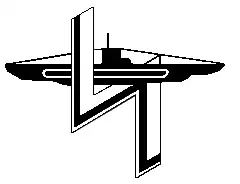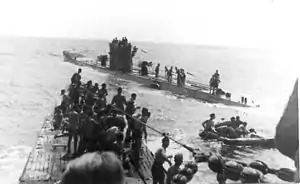 Conning tower emblem of U-156 | |
| History | |
|---|---|
| Name | U-156 |
| Ordered | 25 September 1939 |
| Builder | DeSchiMAG AG Weser, Bremen |
| Yard number | 998 |
| Laid down | 11 October 1940 |
| Launched | 21 May 1941 |
| Commissioned | 4 September 1941 |
| Fate | Sunk on 8 March 1943 |
| General characteristics | |
| Class and type | Type IXC submarine |
| Displacement |
|
| Length |
|
| Beam |
|
| Height | 9.60 m (31 ft 6 in) |
| Draught | 4.70 m (15 ft 5 in) |
| Installed power |
|
| Propulsion |
|
| Speed |
|
| Range |
|
| Test depth | 230 m (750 ft) |
| Complement | 48 to 56 |
| Armament |
|
| Service record | |
| Part of: |
|
| Identification codes: | M 01 308 |
| Commanders: |
|
| Operations: |
|
| Victories: | |
The German submarine U-156 was a Type IXC U-boat of Nazi Germany's Kriegsmarine built for service during World War II. The keel for this boat was laid on 11 October 1940 at the DeSchiMAG AG Weser yard in Bremen, Germany, as yard number 998. She was commissioned on 4 September 1941 under the command of Kapitänleutnant Werner Hartenstein (Knight of the Iron Cross). The city of Plauen, Hartenstein's home city, adopted the submarine within the then popular sponsorship programme (Patenschaftsprogramm), organising gifts and holidays for the crew.
The U-boat took part in five patrols, which included attacks on shipping in which she sank twenty merchantmen, damaged another three merchantmen, and damaged the American destroyer USS Blakeley.
On February 16th, 1942, there were Attacks on Aruba’s oil refineries, Lago Oil and Transport Company and Arend Petroleum Company, which resulted in four fallen Dutch marines.
U-156 was the main participant in the Laconia Incident in September 1942, during which she torpedoed and sank the troopship Laconia west of Africa. Whilst rescuing the survivors and flying the Red Cross flag, the U-boat was attacked by an American aircraft and forced to dive, resulting in the shipwrecked survivors being cast back into the sea. The incident led to the Laconia Order, banning U-boats from attempting rescues, and later caused major embarrassment to the US during the Nuremberg trials.
U-156 was attacked with depth charges by an American aircraft east of the island of Barbados on 8 March 1943. She sank with the loss of all hands.
Design
German Type IXC submarines were slightly larger than the original Type IXBs. U-156 had a displacement of 1,120 tonnes (1,100 long tons) when at the surface and 1,232 tonnes (1,213 long tons) while submerged.[1] The U-boat had a total length of 76.76 m (251 ft 10 in), a pressure hull length of 58.75 m (192 ft 9 in), a beam of 6.76 m (22 ft 2 in), a height of 9.60 m (31 ft 6 in), and a draught of 4.70 m (15 ft 5 in). The submarine was powered by two MAN M 9 V 40/46 supercharged four-stroke, nine-cylinder diesel engines producing a total of 4,400 metric horsepower (3,240 kW; 4,340 shp) for use while surfaced, two Siemens-Schuckert 2 GU 345/34 double-acting electric motors producing a total of 1,000 metric horsepower (740 kW; 990 shp) for use while submerged. She had two shafts and two 1.92 m (6 ft) propellers. The boat was capable of operating at depths of up to 230 metres (750 ft).[1]
The submarine had a maximum surface speed of 18.3 knots (33.9 km/h; 21.1 mph) and a maximum submerged speed of 7.3 knots (13.5 km/h; 8.4 mph).[1] When submerged, the boat could operate for 63 nautical miles (117 km; 72 mi) at 4 knots (7.4 km/h; 4.6 mph); when surfaced, she could travel 13,450 nautical miles (24,910 km; 15,480 mi) at 10 knots (19 km/h; 12 mph). U-156 was fitted with six 53.3 cm (21 in) torpedo tubes (four fitted at the bow and two at the stern), 22 torpedoes, one 10.5 cm (4.13 in) SK C/32 naval gun, 180 rounds, and a 3.7 cm (1.5 in) SK C/30 as well as a 2 cm (0.79 in) C/30 anti-aircraft gun. The boat had a complement of forty-eight.[1]
Service history
Built at DeSchiMAG, Bremen, and commissioned by Kptlt. Werner Hartenstein, the boat was assigned in September 1941 to the 4th U-boat Flotilla for training. She conducted her first patrol from that same month, during which her crew trained, and at the end of which she arrived at her operations base in Lorient, France, in December 1941. From that moment, she was assigned to the 2. Unterseebootsflottille based at that port; from where all her operational patrols departed.
During the three patrols completed in 1942, U-156 sank 19 ships for a total of 97,489 gross register tons (GRT); in addition, three ships were damaged for a total of 18,811 GRT and one warship was damaged for a total of 1,190 tons.
Aruba attack
During its second patrol, U-156 participated in Operation Neuland, which intended to disrupt traffic in the Caribbean; and included an attack on the oil refinery at Aruba island, ordered by captain Hartenstein.
At the beginning of the attack on the Lago Oil and Transport Company San Nicolaas refinery, the deck gun exploded because the cap or tampion in the muzzle of the gun, which prevented water from entering the barrel, was not removed before firing. This accident saved what was at the time the world's largest refinery.
As a result of the accident, Matrosengefreiter (equivalent to Able Seaman or Leading Seaman) Heinrich Bussinger was killed, and Gunnery Officer Dietrich von dem Borne lost his right leg in the explosion. He was taken below and the boat submerged and left the waters off the coast of Aruba. Von dem Borne was put ashore on the island of Martinique for medical treatment and survived the war. The stop at Martinique, at the time part of Vichy France contributed to the worsening of diplomatic relations between the US and Vichy France.
Laconia incident

On 12 September 1942, U-156 hit the British troopship Laconia on the starboard side with a torpedo. The troopship, carrying 463 officers and crew, 80 civilians, 286 British Army soldiers, 1,793 Italian prisoners of war, and 103 Polish soldiers (guards) off the coast of West Africa, was hit by a second torpedo on Number Two hold and sank. After realising that the passengers were primarily POWs and civilians[2] the U-boat started rescue operations while flying the Red Cross flag. A U.S. Army Air Corps bomber flying out of a secret South Atlantic airbase on Ascension Island attacked the U-boat. The U-boat abandoned the rescue effort and left the survivors to drift to Africa. Over half the survivors died. This incident led to German Admiral Karl Dönitz issuing the Laconia Order on 17 September 1942, which forbade submarine commanders from rescuing survivors from torpedoed ships.
Fate
During her fifth patrol, in which she sank no shipping and made no attacks, U-156 was attacked twice. As a result of the second attack, on 8 March 1943, she was sunk approximately 280 nautical miles east of the island of Barbados, in position 12°38′N 54°39′W / 12.633°N 54.650°W, by a US PBY Catalina from VP-53 captained by Lieutenant E. Dryden. The aircraft dropped four Mark 44 Torpex-filled depth charges at 13:15 from an altitude of 75 feet (23 m) to 100 feet (30 m) which straddled the submarine. Two were observed to hit the water 10 feet (3.0 m) to 15 feet (4.6 m) starboard and just aft of U-156, lifting it and breaking it in two, followed by an explosion. At least eleven survivors were seen swimming in the water. Two rubber rafts and rations were dropped, and five men were seen to reach one of the rafts. USS Barney was dispatched from Trinidad to rescue the survivors, but without success; the search was abandoned on 12 March 1943.
Patrols
| Commander | Departure | Arrival | Duration | Victories | |||
|---|---|---|---|---|---|---|---|
| 1 | Kptlt. Werner Hartenstein | 24 December 1941 | Kiel | 10 January 1942 | Lorient | 18 days | |
| 2 | Kptlt. Werner Hartenstein | 19 January 1942 | Lorient | 17 March 1942 | Lorient | 58 days | 33,492 GRT |
| 3 | Kptlt. Werner Hartenstein | 22 April 1942 | Lorient | 7 July 1942 | Lorient | 77 days | 53,617 GRT |
| 4 | K.Kapt. Werner Hartenstein | 20 August 1942 | Lorient | 16 November 1942 | Lorient | 89 days | 30,381 GRT |
| 5 | K.Kapt. Werner Hartenstein | 16 January 1943 | Lorient | 8 March 1943 | sunk | 52 days | |
| Total | 294 days | 117,490 GRT | |||||
Note : Kptlt.=Kapitänleutnant – K.Kapt.=Korvettenkapitän
Wolfpacks
U-156 took part in one wolfpack, namely:
- Eisbär (25 August – 1 September 1942)
Summary of raiding history
U-156 is credited with the sinking of 19 ships, for a total of 97,489 GRT, further damaging three ships of 18,811 GRT and damaging one warship, USS Blakeley, of 1,190 tons.[3]
References
Notes
- ↑ Merchant ship tonnages are in gross register tons. Military vessels are listed by tons displacement.
Citations
- 1 2 3 4 Gröner 1991, p. 68.
- ↑ Doenitz, Grand Admiral Karl Memoirs, Ten Years and Twenty Days: Frontline Books, 1990, p. 255.
- ↑ Röll 2011, pp. 153–154
- ↑ Helgason, Guðmundur. "Ships hit by U-156". German U-boats of WWII – uboat.net. Retrieved 7 December 2014.
- ↑ "SS Quaker City. Torpedoed 18th May 1942. The story of John Heller". bajanthings.com. 14 August 2018. Retrieved 22 February 2021.
Bibliography
- Busch, Rainer; Röll, Hans-Joachim (1999). German U-boat commanders of World War II : a biographical dictionary. Translated by Brooks, Geoffrey. London, Annapolis, Md: Greenhill Books, Naval Institute Press. ISBN 1-55750-186-6.
- Busch, Rainer; Röll, Hans-Joachim (1999). Deutsche U-Boot-Verluste von September 1939 bis Mai 1945 [German U-boat losses from September 1939 to May 1945]. Der U-Boot-Krieg (in German). Vol. IV. Hamburg, Berlin, Bonn: Mittler. ISBN 3-8132-0514-2.
- Gröner, Erich; Jung, Dieter; Maass, Martin (1991). U-boats and Mine Warfare Vessels. German Warships 1815–1945. Vol. 2. Translated by Thomas, Keith; Magowan, Rachel. London: Conway Maritime Press. ISBN 0-85177-593-4.
- Röll, Hans-Joachim (2011). Korvettenkapitän Werner Hartenstein: Mit U 156 auf Feindfahrt und der Fall "Laconia" (in German). Würzburg, Germany: Flechsig. ISBN 978-3-8035-0012-0.
External links
- Helgason, Guðmundur. "The Type IXC boat U-156". German U-boats of WWII – uboat.net. Retrieved 7 December 2014.
- Hofmann, Markus. "U 156". Deutsche U-Boote 1935–1945 – u-boot-archiv.de (in German). Retrieved 7 December 2014.